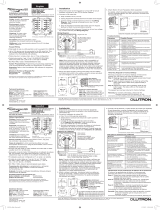
P/N 03-0210-501-0300-03 • ISS 04NOV22 11 / 26
La gamme comprend les modèles suivants.
Déclencheur manuel d’alarme adressable
intelligent rouge
Déclencheur manuel d’alarme adressable
intelligent rouge avec isolateur de court-circuit
intégré
[1] Également disponible en bleu, vert, orange, blanc et jaune.
Figures
Figure 1 : Trous de fixation et dimensions
2 : Bornier avant et DIP Switch
3 : Déverrouillage du couvercle avant
4 : Retrait du couvercle avant
Figure 5 : Retrait de l’élément réinitialisable
6 : Remise en place du couvercle avant
Installation
Attention : ce produit doit être installé et entretenu par une
personne qualifiée, conformément à toutes les normes
nationales et régionales, et à toutes les autres réglementations
applicables.
Adressage
Avant de procéder à l’installation, configurez l’adresse du
dispositif à l’aide du DIP Switch, situé à l’arrière du boîtier
avant (reportez-vous à la Figure 2).
001-128 correspond à la plage d’adresses. Reportez-vous au
tableau se trouvant sur la dernière page de ce document afin
d’obtenir des informations sur le positionnement du DIP Switch
pour chaque adresse.
Remarque : si vous modifiez l’adresse du dispositif après
l’installation, vous devez déconnecter le dispositif de
l’alimentation en boucle pendant au moins une seconde, puis
le reconnecter afin que la nouvelle adresse soit reconnue.
Installation
Le déclencheur manuel d’alarme peut être monté en surface
ou encastré.
En cas de montage en surface, commandez l’un des boîtiers
arrière indiqués dans le tableau ci-dessous.
Description
-MC-BB-R Boîtier arrière rouge
-MC-BB-U Boîtier arrière bleu
-MC-BB-G Boîtier arrière vert
-MC-BB-O Boîtier arrière orange
-MC-BB-W Boîtier arrière blanc
-MC-BB-Y Boîtier arrière jaune
En cas de montage encastré, commandez l’un des
adaptateurs indiqués dans le tableau ci-dessous et, si
nécessaire, l’un des caches également mentionnés.
-MC-AFM-R Adaptateur d’encastrement rouge
-MC-AFMG-R Adaptateur d’encastrement rouge avec pinces
-MC-S-R Cache rouge
-MC-AFM-G Adaptateur d’encastrement vert
-MC-S-G Cache vert
Assurez-vous de retirer le cache anti-poussière après la mise
en service.
Remarque : le cache anti-poussière peut également être
utilisé pour indiquer que l’unité n’est pas opérationnelle (par
exemple, avant la mise en service, en cas de maintenance ou
de désactivation, etc.)
Pour monter le déclencheur manuel d’alarme en surface :
1. Fixez le boîtier arrière au mur à l’aide de quatre vis M4
(non fournies) et faites passer le câble à travers les sorties
de câble de votre choix.
En fonction du type d’installation, le boîtier arrière peut
comporter deux sorties de câble sur le haut et une sur le
bas, ou une sur le haut et deux sur le bas.
Reportez-vous à la Figure 1 pour consulter l’emplacement
des trous de fixation.
2. Connectez le câble au bornier fourni, puis branchez ce
dernier au connecteur CCI à l’arrière du boîtier avant
(reportez-vous à la Figure 2).
À l’aide du câble de liaison fourni, testez la continuité du
câble avant de brancher le bornier au connecteur CCI à
l’arrière du boîtier avant.
Reportez-vous à la section Câblage ci-dessous, dédiée
aux connexions du bornier et aux caractéristiques du
câble.
3. Déverrouillez et retirez le couvercle avant, puis retirez
l’élément réinitialisable.
Pour déverrouiller le couvercle avant, insérez la clé et
tournez-la dans le sens des aiguilles d’une montre. Dès
que vous entendez deux clics, tirez le couvercle vers le
bas pour le retirer (reportez-vous aux Figures 3 et 4).
Pour retirer l’élément réinitialisable, poussez l’élément
vers le haut, puis retirez-le (reportez-vous à la Figure 5).
4. Fixez la face avant au boîtier à l’aide des deux vis fournies
(situées dans le boîtier).
5. Remettez l’élément réinitialisable en place (ou ajoutez
l’élément sécable, le cas échéant), puis replacez le
couvercle avant (reportez-vous à la Figure 6).
Tournez la clé dans le sens inverse des aiguilles d’une
montre (jusqu’à ce que vous entendiez deux clics) pour
verrouiller le couvercle, puis retirez la clé.
Enfin, testez le déclencheur manuel d’alarme (reportez-vous à
la section Tests, à la page 12).




















